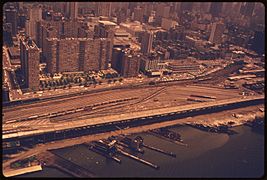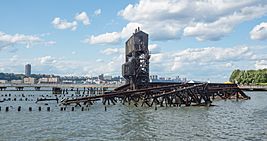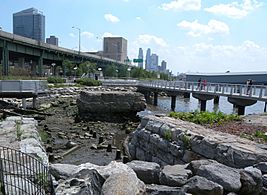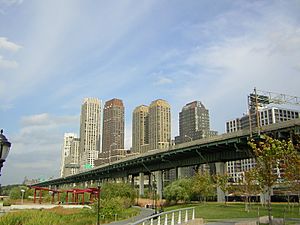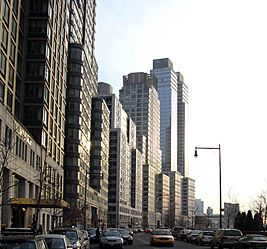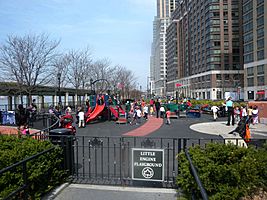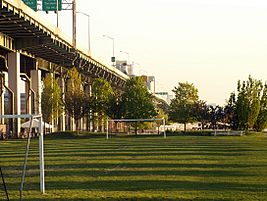Riverside South, Manhattan facts for kids
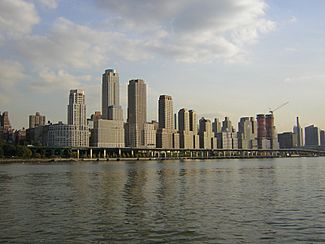
A view of the complex from the Hudson River
|
|
| Other name(s) | Trump Place and Riverside Center (for parts) |
|---|---|
| Location | Manhattan, New York City, New York |
| Coordinates | 40°46′41″N 73°59′20″W / 40.778°N 73.989°W |
| Status | All buildings complete; highway relocation begun, but incomplete. |
| Groundbreaking | 1997 |
| Constructed | 1997–2020 |
| Use | Residential |
| Website | ExtellDev |
| Companies | |
| Architect | Daniel Gutman and Paul Willen; Marilyn Taylor and David Childs, SOM |
| Developer | The Trump Organization, Hudson Waterfront Associates, Extell Development Company |
| Owner | Extell Development and The Carlyle Group |
| Planner | Riverside South Planning Corporation |
| Technical details | |
| Cost | US$3 billion |
| Buildings | 19 |
| Size | 8.4 million square feet (780,000 m2) |
| No. of residents | over 8,000 as of 2012 |
| Proposed | 1989 (other plans proposed since 1962) |
Riverside South is a huge building project in the Lincoln Square area of Manhattan, New York City. It's on the Upper West Side, a busy part of the city. This project was started by six community groups working with real estate developer Donald Trump.
The area used to be a large train yard. Now, it's mostly a place where people live. It includes buildings called Trump Place and Riverside Center. This big project cost about $3 billion and covers 57 acres (23 ha) of land. It stretches along the Hudson River between 59th Street and 72nd Street.
Building on this land caused a lot of discussion in the community. Earlier plans by Trump in the 1970s were not popular. In 1982, a smaller project called Lincoln West was approved, but it didn't get enough money. Planning for the current Riverside South project began in the late 1980s.
The first plans for Riverside South included 16 apartment buildings. These would have up to 5,700 homes. There would also be space for studios, offices, and shops. A 25-acre (10 ha) park along the river was also part of the plan. Trump later sold the project to investors from Hong Kong and China. Construction began in 1997. In 2005, the investors sold the remaining parts to other companies.
Contents
History of the Land: The 60th Street Rail Yard
The land where Riverside South now stands was once a large train yard. It belonged to the New York Central Railroad. This yard was located between 59th and 72nd streets. In the 1800s, much of this area was still under water. By 1880, land was added to create the huge 60th Street Yard.
In the 1930s, New York City's parks commissioner, Robert Moses, made big changes. He covered the train tracks north of 72nd Street. This project also moved train lines underground south of 60th Street. It created the Henry Hudson Parkway. The nearby Riverside Park was also made bigger. It now stretched to the Hudson River.
Until the 1970s, the rail yard area was mostly industrial. A printing plant for The New York Times was there. ABC television studios were also in the area. In 1962, there was a plan to build "Litho City" with 5,300 apartments. It would be built on a platform over the tracks.
The New York Central Railroad later joined with another company to form Penn Central. But the train lines were having money problems. The railroad went bankrupt in 1971. After that, the train yard was no longer used for trains.
Planning for New Buildings
Early Ideas and Lincoln West
After the train company went bankrupt, its land was sold. In 1974, Donald Trump got the option to buy the land for $10 million. He wanted to build many homes, up to 20,000 or 30,000. But people in the neighborhood were against such a large project. Trump then made his plans smaller.
In 1979, an Argentine company bought the property. In 1982, a plan called Lincoln West was approved. It was a large project, mostly for homes. However, the builders couldn't get enough money. So, the project didn't happen. In 1985, Trump bought the rights to the land for $95 million. This gave him full control of the old train yard site.
Television City Proposal
In 1985, Trump suggested a huge project called Television City. It would have offices for NBC and TV studios. The plan included 15.5 million square feet (1,440,000 m2) of homes, shops, offices, and studios. There would be 7,600 homes and a large shopping mall. The main building was planned to be 150 stories tall. Six other towers would be 76 stories high.
Many people thought Television City was too big. An architecture critic said it treated the city like a "game board." Another critic worried it would make the area too crowded. Residents formed a group called Westpride to fight the plan. They raised money and got famous people to help.
Trump tried to get tax breaks for NBC to move there. But the mayor, Ed Koch, gave the tax breaks directly to NBC instead. NBC decided to stay at Rockefeller Center. Trump then made the project smaller and renamed it Trump City. He also said 760 homes would be for older people who couldn't afford much.
Community groups also worked on their own plan. They wanted to keep the Upper West Side's character. They suggested extending Riverside Park and limiting new buildings. Trump City did not match these ideas, so people still opposed it.
The Riverside South Plan
In 1989, six community groups proposed a different plan. It was designed by Daniel Gutman and Paul Willen. This plan was called Riverside South. It was mostly for homes and was the same size as the previously approved Lincoln West. This plan involved moving the West Side Highway and partly burying it. This would make space for a 23-acre (9.3 ha) expansion of Riverside Park.
Trump was facing money problems. So, he agreed to work with his critics. This group was called the Riverside South Planning Corporation (RSPC). A newspaper critic said the new Riverside South plan had a "real chance of being a cause for celebration."
The RSPC plan was approved in 1992. It did not include the TV studios or office space Trump had wanted. The final project size was 6.1 million square feet (570,000 m2). A big new park was promised. Also, Freedom Place, a street behind some buildings, would be improved. A monument to civil rights workers would be added there.
Some people still had concerns. They worried the project was bigger than Lincoln West. They also worried about more traffic and crowding at the subway station. Some residents were upset that their views would be blocked. Others didn't want their quiet street to become a through street.
Most of these issues were solved during the approval process. Trump agreed to make the project a bit smaller. He also agreed to help pay for subway station improvements. He promised that at least 12% of the homes would be affordable. The development would also pay for building and keeping up the new public park. Still, some people, like Rep. Jerry Nadler, thought the park would be like a "private backyard" for the new residents.
Building the Project
Starting Construction
Trump needed to pay back a bank. So, he sold most of his share of the project. He sold it to a group of investors from Hong Kong and China. They paid $82 million to the bank. This deal started the biggest private building project in New York City's history. Trump remained the public face of the project.
Construction was delayed for several years. There were lawsuits and the new investors looked for public money. Trump was accused of trying to get special favors from a state leader. The state loan was never given.
Building was supposed to start in 1995, then 1996, and finally in January 1997. When the economy got better, the new investors began building in 1997. They put the name "Trump Place" on three buildings. Trump stopped being actively involved in 2001, but he still owned 30% of the project.
In 1997, a problem was found with the concrete in one building. The city stopped construction on 300 Riverside Boulevard. Workers had to tear out the bad concrete and pour new concrete. Work started again in early 1998.
Moving the West Side Highway
One important part of Riverside South was moving the West Side Highway. It was an elevated road. The plan was to move it eastward and put it in a tunnel. This would create more space for Riverside Park. The section of highway between 72nd and 59th Streets is the last part of an old elevated highway. This highway closed in 1973 after a part of it collapsed.
Robert Moses had suggested moving the highway to ground level. This would help expand Riverside Park. But the state didn't like the idea. It would cost too much. Also, the city was having money problems in the 1970s.
When the Riverside South plan was approved in 1992, Trump agreed to give the land for the park and highway. He also agreed to build a public park with private money. But some people argued that public money to bury the road would only help the developer. The mayor and governor also didn't want to move the highway right away. They said it would waste money spent on fixing the old elevated road.
Still, planning for the highway continued. In 2001, the plan was approved. It involved moving the elevated highway to ground level. A tunnel would be built for the northbound lanes. The park would be built above this tunnel and another tunnel for southbound lanes. In 2006, construction of the northbound tunnel began. However, the rest of the tunnel is still not finished.
Opening and New Developers
The project was built by the Trump Organization and Hudson Waterfront Associates. This group represented the Hong Kong investors.
In 2005, the Chinese investors sold the project. They sold it to the Carlyle Group and the Extell Development Company. Trump sued his partners, saying they sold it for too little money. But he lost the lawsuit. Carlyle and Extell then sold three apartment buildings to another company.
In 2008, Extell suggested a new plan for the southern part of the project. This plan was for a 2,900,000-square-foot (270,000 m2) residential project. It was called Riverside Center. The City Council approved it in 2010.
Buildings and Parks
Buildings
More buildings were completed when the housing market got better. Extell finished three buildings: The Avery, The Rushmore, and The Aldyn. The Riverside Center buildings were approved in 2010.
Overall, Riverside South has 19 apartment buildings. Some are condominiums, which means people own their apartments. As of 2012[update], over 8,000 people lived there. The area is sometimes called "Riverside Boulevard" or "The Strip." Six more towers are still to be built. These will have 3,000 homes, a school, a hotel, shops, and a movie theater. A 3.4-acre (1.4 ha) park between the buildings is also planned.
Most homes in Riverside South are expensive. Prices went up a lot between 2004 and 2014. For example, baseball player Alex Rodriguez bought a condo for $5.5 million and sold it for $8 million a year later.
Some buildings in the project have affordable homes. This was required by the city. However, some buildings, like One Riverside Park, caused controversy. They had separate entrances for residents with affordable housing. These are sometimes called "poor doors."
As of November 2014[update], the last two Riverside South projects were being finished. These included One West End, a condo building, and a rental building at 21 West End Avenue. These buildings would have many affordable homes. They were being built with a public school and shops. The developers planned to sell the remaining land to another company. In the same year, Collegiate School announced plans for a new campus building.
After the 2016 presidential election, residents asked to remove the name "Trump Place." The owner of three buildings agreed to take the name off. Residents said they didn't like Donald Trump's behavior during his presidential campaign.
Parks
The new 25-acre (10 ha) Riverside Park South expands Riverside Park. The first part of the park opened in 2001. Pier I, an old train pier, was rebuilt. It is 795 feet (242 m) long. More sections of the park opened in 2003 and 2006. A new path for bikes and walking was also built. It connects Hudson River Park with Riverside Park.
The design for the last parts of the park depends on when the highway is moved. The city plans to add new baseball and soccer fields, lawns, and picnic areas. Construction for these parts will start in 2017. Moving the highway will require some changes to the park.
The park has special sculptures and old train ruins. It also has gardens and a walkway along the river. Parts of the old train yard, like the New York Central Railroad 69th Street Transfer Bridge, were kept in the new park. This bridge was added to the National Register of Historic Places in 2003. Many old train yard ruins were included in the park. Train company logos are even carved into park benches.
Other Structures in the Area
Some community members said Trump didn't build a planned monument at Freedom Place. However, the Riverside South Planning Corporation said it was just an idea for an arts program. It was not part of the final project.
A street called Freedom Place South runs from 64th Street to 59th Street. The historic IRT Powerhouse and the Riverside Center building are located there. Near the Powerhouse, there is a new building shaped like a tetrahedron. It is called VIA 57 West.


